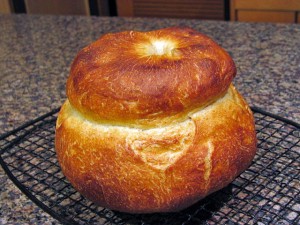The many names of bread

A cottage loaf. Image from Bewitching Kitchen
Living as I do in Mendocino, CA, I am blessed with access to excellent local bakeries offering a wide variety of breads. I was amused to find in my old black filing cabinet this article I wrote for my New Zealand newspaper about discovering there were more names for bread than “white” and “brown.”
Slindon Bakery’s website has many pictures of these traditional English breads.
A Loaf by Any Other Name
London, 1962
The shelves of a baker’s shop anywhere in New Zealand will be much the same—piled high with round-topped loaves in brown or white, square white sandwich loaves, and pre-cut wrapped bread, and although North Islanders and South Islanders may argue for hours over whether the broken half of the double loaf should be called a “half” or a “quarter”, they will usually be able to make themselves understood in any bakery.
Imagine then the confusion of a New Zealand housewife confronted with the window of an English bakery, filled with loaves in an incredible variety of shapes and sizes. Some of the shapes are wonderfully decorative. There will be long thin loaves and short fat ones, some decorated with grain and some with shining glazes. There will be complicated plaits and squat little knots, enormous swelling crusty loaves, and incredibly long thin rolls that look as if they have been transplanted from the Continent.
The vagaries of English custom have established different names for these traditional shapes from town to town, and sometimes even from shop to shop in the same town.
The biggest and crustiest loaf of them all is usually called a “farmhouse.” It is a tall white loaf, often bursting from a long crack in its top. It has a close relation in the “split tin”, which does not appear to be split at all, but merely a white loaf, again with a cracked top, baked in a narrow oblong tin. These loaves are not to be confused with the “Danish”, which is not baked in a tin at all, but rises as a large oval loaf, dusted with white flour, from a flat tray.
Then there are the more elaborate shapes, such as the “cottage”, often confused with the “farmhouse”. The “cottage” is made with two balls of dough, the smaller being set like a top-knot on top of the larger. Another even more complicated one is the double plait, which contains, as its name implies, two plaits of dough set one on top of the other.
Some of the small round loaves have fascinating names. There is a ball of rich wholemeal bread decorated with wheat grains, which is called, appropriately enough, a “round meal”, but the white ball, this time with a shining brown glaze, is known as a “cob.” This is reputed to be short for “Coburg”, but where this name came from few seem to know.
The origins of other names are more obvious. One delicious scone loaf, which is sold in quarter segments of a large flat disk, is known in England as “Scotch fare”. In Wales, however, they are sold as “Welsh babs”.
A small light white loaf with a shiny glazed crust decorated with diagonal slashes, and known as a “Continental”, has a large elder brother with various titles, but usually known as a “twist” or a “bloomer”. This odd name can cause difficulties, and it has happened that an order for “A large bloomer, thank you” has met with raised eye-brows from the shops that have not heard of this title. In most cases, it is safer to point: “That one over there” and then politely ask the name of the specimen as it is being wrapped up.
I am afraid I would be in a pickle if I were to go abroad. But since I am not shy I would ask. thanks Maureen. Very interesting
Love reading your stories, Maureen. Thanks! Looking forward to other discoveries form the filing cabinet. 🙂
Great! Love your “old” stories!
Maureen,
Fascinating article. We learn something new all the time.
thank you for informing me.
Alice